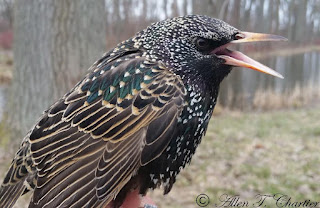During November of 2014, one day in May 2015, and several days in fall of 2015, a new banding area was explored, with good results. New net lanes were established, with the plan to move forward with banding in a new area, and new habitat, adjacent to the Meadow Loop of the Nature Trail. This new site is located 0.4 miles northeast of the Point Rosa Marsh station, and the net locations are shown below.
In this new area, a total of 15 nets (four 18-meter nets and eleven 12-meter nets, which is 17.5 "standard" nets) will be used in an area that can be encompassed by a circle with an area of 3 acres. The Point Rosa site had a total of 14 nets (15 standard nets). There are six net groups of nets that are color-coded on the map above, and will be tracked for the birds captured in them. White shows what we're calling the Pine Nets, an "L" configuration and a single net. They cut across a row of pines that were planted here in the 1990s and have now grown to more than 20 feet tall. In green are the Meadow Nets, which are on the edge of the pines in an area of open field, where several Tree Swallow nest boxes have been maintained for many years. The single net shown in red is in a dogwood and sumac thicket adjacent to the pines, and is called the Thicket Net. In yellow are four nets in an open area surrounded mostly by dogwood and some cottonwoods which we're calling the Dogwood Nets. This was a very good area for American Woodcocks during 2015, and there were some in the area this spring too. In blue are nets adjacent to a channel that runs east-to-west, and are called the Channel Nets. And finally, the single net in black is called the Bat Net, because it is adjacent to the bat hibernation box that has been in the center of the Meadow Loop for many years.
On April 3, a hardy team of volunteers and I banded at this new station for the first time in 2016, a new beginning to banding in the park. Hopefully the habitat will be managed in a way that there is some consistency for years to come, and will not affect our efforts. It was a very cold morning, starting off at about 25 degrees. So, partly to wait until the temperatures rose a bit, and partly because we were locked out of the park until 7 a.m., we did not get nets open until well after sunrise. So, the hoped-for capture of American Woodcock did not happen, but other species that area around only in early April were captured, including American Tree Sparrow and Golden-crowned Kinglet.
 |
| After hatch-year American Tree Sparrow |
 |
| After hatch-year female Golden-crowned Kinglet |
White-throated Sparrows were also captured, which might be overwintering individuals since the peak of migration here is still about three weeks away.
 |
| After hatch-year White-throated Sparrow |
Two other species that were captured, not highlights, were only rarely captured back in the Point Rosa Marsh, but being so close to the feeders at the Nature Center, I suspect we'll be capturing more European Starlings and House Sparrows in the future.
 |
| After hatch-year female European Starling |
A few individuals that were already banded, back in 2015 or November 2014, were recaptured today including the first bird of the day, a Song Sparrow, and a Black-capped Chickadee.
 |
| After hatch-year Song Sparrow |
 |
| After hatch-year Black-capped Chickadee |
But the clear highlight of the day, and quite a surprise, was TWO adult male Yellow-bellied Sapsuckers. Over the 10 years in Point Rosa Marsh, only 4 were banded and all of those were hatch-year birds, in brown plumage. Both sapsuckers today were in very fine plumage.
 |
| After second-year male Yellow-bellied Sapsucker |
 |
| After second-year male Yellow-bellied Sapsucker |
Bird Banding Results
April 3, 2016
Time open (E.S.T.): 8:00 (cold delayed opening)Time closed (E.S.T.): 12:30 (snow forced early close)
Hours Open: 4.5
Net Hours: 78.75
Temperature (F): 27-32
Cloud Cover: 20-100%
Wind Direction: WSW
Wind Speed (mph): 7-10
Barometer: 30.03 (steady all day)
Precipitation: Intermittent Light Snow
No. Banded: 27 (plus 6 recaptured)
Species Captured: 11
Capture Rate: 41.9/100 net hours
Banding Assistants (8.5 hours worked): Jacob Charlebois (2 hrs), Stevie Kuroda, Joan Tisdale, Bruce Watson, Christian Sammit, Julian Zammit.
Yellow-bellied Sapsucker - 2
Black-capped Chickadee - 1 (plus 1 recaptured)
Brown Creeper - 1
Golden-crowned Kinglet - 9
American Robin - 5 (plus 1 recaptured)
European Starling - 1
American Tree Sparrow - 3
Song Sparrow - 2 (plus 3 recaptured)
White-throated Sparrow - 2
[Northern Cardinal - 1 recaptured]
House Sparrow - 1
--------------------------------------------------




1 comment:
Been trying to reach you re 1st hummingbird male sighted 4/15 in Grand haven MI. Have pics. Former email account is not working. Where shall I send it? Joy Welch.
Post a Comment